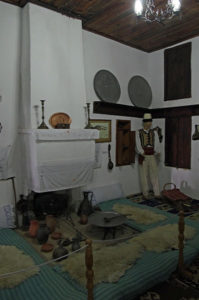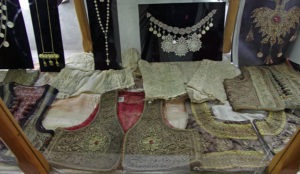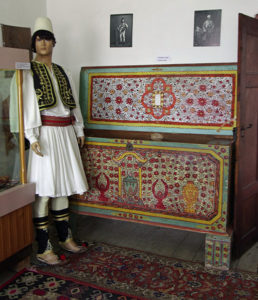Apart from towns like “Gjirokastra”:http://wasleys.org.uk/eleanor/otherholidays/albania/day_four/four_two/index.html and “Berat,”:http://wasleys.org.uk/eleanor/otherholidays/albania/day_six/six_one/index.html few old houses survived the Communist and post communist development. Even fewer are open to visitors. There is the lovely “Skendule House”:http://wasleys.org.uk/eleanor/otherholidays/albania/day_four/four_four/index.html in Gjirokastra and the ethnographic Museum in Kruje. This is in a lovely old house built in 1764 which belonged to one of the wealthy families living within the castle. It escaped demolition when the “Skanderbeg Museum”:http://wasleys.org.uk/eleanor/otherholidays/albania/day_eight/eight_one/index.html was built.
The house is set in a walled courtyard with two gateways and is a typical Ottoman style house with storage rooms or workshops on the ground floor with the living quarters above. Most of the items seen are original.
We were taken round by a local guide which was helpful as there are no labels or information in the house.
In the porch is a hand worked quern, equipment for making leather and a machine used to crush wheat. One of the ground floor rooms contained a forge. Another has a small water driven mill to grind flour. There was a display on making traditional felt hats as well as a machine for washing the felt. This room had a small shelter for the sheep in one corner with accommodation for the shepherd above. Another room contained a large oil crush which would have been worked by a donkey and a press to extract the oil. One room contains a still used for making raki, an unsweetened, occasionally anise-flavored, alcoholic drink that is popular in Albania. It can be lethal.
Upstairs were the living quarters, with rooms off a large central hallway. Doorways are low so people had to bow to enter or leave the room, thus showing respect. There are display cases with wedding clothes of both bride and groom.
Men and women were segregated. The womens room also doubled up as the ceremonial room. It has a painted frieze running round the top of the walls and stained glass windows.
The mens room had a fireplace and examples of weapons and musical instruments were hanging on the walls. Above the doorway is a gallery where the women could sit and watch to see when the men wanted anything to eat or drink. As marriages were arranged this was often the first view a girl would have of her future husband.
Next to it is a small hamman with the family room beyond, which has a small handloom.The balcony looking down on this was used by the children.
As well as being used for cooking, the kitchen was where the grandparents slept close to the fire on low mattresses.
The last room was originally a bedroom, but now contains displays of clothes as well as a beautiful 140 year old painted dowry chest.
This was a fascinating visit, showing a way of life long gone. It also helped to understand the old houses we had admired in both Gjirokastra and Berat.
There are more pictures “here.”:http://wasleys.org.uk/eleanor/otherholidays/albania/day_eight/eight_two/index.html










